          |
Preparing
The NRO For The Future
The
NRO must constantly engage in the most advanced research, development
and acquisition efforts so that it can continue to place the latest
and best reconnaissance capabilities in orbit.
Timely, high
quality space reconnaissance based on technological innovation
is of crucial importance to both strategic and tactical decision-makers.
To provide this, the NRO must constantly engage in the most advanced
research, development and acquisition efforts so that it can continue
to place the latest and best reconnaissance capabilities in orbit.
The Commission concludes that significant actions must be taken
to enable it to do so, and that these actions should reflect those
qualities, characteristics and attributes, as summarized below,
that enabled the NRO to achieve its great past successes.
Engineering
Creativity. While new NRO systems have responded to the
desires of external customers, NRO engineers have also been
free to pursue "the art of the possible" and to develop
new technological solutions to solve intelligence problems whenever
feasible. This has allowed NRO engineers to focus on improving
system performance, rather than being limited by rigid, consensus-driven
customer requirements. Given wider latitude, they have been
more creative. Thus, the NRO is accustomed to delivering first-of-a-kind
satellites.
Performance
First. In making design choices for new NRO systems and
upgrades, superior satellite performance has been considered
more important than constraining costs. Budget constraints have
not been ignored, but sufficient funds have been made available
to the NRO to pursue promising new technologies.
End-to-End
Systems Approach. The NRO's distinctive approach has included
end-to-end development of space reconnaissance systems. While
developing a concept of operations for a future satellite system,
NRO program developers considered how, by whom and under what
conditions the system would be tasked. While determining how
raw satellite data would be transformed into a useful product,
they considered mission ground station operations. In some cases,
they actually developed TPED tools and techniques to be used
in conjunction with the new satellite system. Understanding
the entire process permitted the development of break-through
satellite systems and the capabilities required to support them.
Cradle-to-Grave
Perspective. In some cases, NRO engineers have also operated
the satellites they designed and built, thus developing unique
and important insights into possible future capabilities. Among
other things, solving on-orbit anomalies, watching and understanding
the changes in intelligence targets, and incorporating new hardware
and software upgrades have contributed to a thorough NRO understanding
of space reconnaissance systems and the targets they must attack.
Senior
Level Attention. One of the most important reasons for the
NRO's success has been the partnership between the Secretary
of Defense and the DCI, explained in further detail in this
Report, that has permitted the creation of a single vision for
space reconnaissance and allowed the NRO to operate differently
than other activities in the national security community.
From its
earliest days, the NRO collected information essential to strategic
and tactical decision-makers. Part of the DCI's contribution
to the partnership has been advocacy, on behalf of the Intelligence
Community, for crucial strategic intelligence collection that
can only be conducted from space. As the President's primary
intelligence advisor, the DCI requires substantial amounts of
such information. At the same time, the Secretary of Defense,
representing the other half of the partnership, requires NRO
information to ensure global situational awareness and battlefield
information dominance for his military commanders.
Special
Authorities. The Secretary of Defense-DCI partnership also
has provided the NRO with the authority to use extraordinary
policies and procedures to advance its efforts. Among these
are the NRO's exemption from normal DoD procurement policies,
procedures and regulations. The NRO has also been allowed to
use the DCI's special statutory procurement authorities under
Title 50 of the U.S. Code. These authorities helped provide
the foundation for the NRO's unique acquisition process and
its exceptional relationships with contractors.
Unified
Direction. The Secretary of Defense and DCI agreed to establish
a single NRO Director with a single vision based upon a single
space reconnaissance budget. Internal disagreements involving
competing demands for constrained NRO resources are settled
by one Director within one organization, based upon an understanding
that space reconnaissance is essential for the success of DoD
and the Intelligence Community.
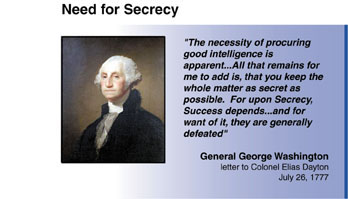
Special
Security Protections. Until 1992, the NRO was surrounded
by a wall of secrecy. This environment kept foreign intelligence
services from gaining a comprehensive understanding of U.S.
space reconnaissance capabilities. The absence of information
on NRO spacecraft attributes, sensors and its approach to the
development of new technology hampered those who intended to
use cover and denial and deception techniques to counter U.S.
space reconnaissance. As a result, knowledge of the NRO was
limited.
Experienced
Program Managers. NRO program managers have been experienced
military and CIA acquisition officers. Many have spent almost
their entire careers within the NRO working in many different
capacities. Because they were highly qualified acquisition professionals
and understood NRO activities so well, they required little
supervision and were empowered to make decisions not normally
made at their level in other parts of the U.S. Government. They
could reallocate funds to meet unforeseen circumstances and
could take advantage of opportunities to adopt new technologies.
With clear guidance from senior Government officials and sufficient
resources, they were able to make decisions in technically risky
programs and produce very successful, advanced space reconnaissance
systems.
The
Impact of Change. The current environment within which the
NRO must operate has had an unfortunate effect on these characteristics,
which have been so important for the NRO's past successes. For
example, the integration of NRO information into many day-to-day
decision-making processes has made many national security professionals
very familiar with NRO programs. Many have come to expect the
NRO to adapt to standard procedures in order to accommodate
the needs of a wide array of customers.
The NRO
now must respond to rigid requirements for new reconnaissance
systems, based on extensive negotiations among a wide variety
of strategic and tactical customers. Because resources are constrained
across the Intelligence Community, cost constraints have become
an increasingly important element in decisions on new NRO programs.
There have
been other important changes. The Secretary of Defense-DCI partnership
is being managed to a large extent by subordinates or staffs.
The NRO is now a publicly acknowledged organization. Some of
its latest space reconnaissance initiatives are well-publicized
and NRO systems are analyzed and discussed on the Internet.
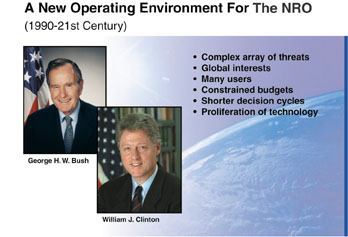
Thus, the
NRO is operating under very different conditions from those
under which it achieved its greatest successes. Nonetheless,
new, extremely difficult intelligence problems will continue
to arise that will require frequent, assured, global access
to denied areas. This is the NRO's unique contribution to intelligence
and should be the driving force behind its efforts.
The
Office Of Space Reconnaissance
Because
of the NRO's changed circumstances, the Commission concludes
that the NRO Director must free his most advanced research,
development and acquisition efforts from processes that inhibit
his ability to place the latest and best reconnaissance capabilities
on orbit quickly. The Commission believes the best way to do
this is to create a new office that builds on the sources of
the NRO's past successes and reflects the characteristics of
its successful programs. It suggests the new office be called
the Office of Space Reconnaissance (OSR).
The first
and foremost premise in establishing this Office must be that
it responds only to requirements from the President, Secretary
of Defense and DCI through an Executive Committee (EXCOM) and
to congressional oversight. By implication, the Office's budget
would be relatively small and it would focus only on the most
significant problems confronting the three principal decision-makers
and that require space-based reconnaissance solutions. Because
these officials would give the new Office their personal attention,
they would exempt the Office from normal DoD acquisition regulations
and allow it to use, when appropriate, the DCI's special authorities
under 50 U.S.C. 403j. Further, their personal involvement and
support would give important impetus to the Office's programs
as they wind their way through the complicated budget and oversight
process.
Second,
the Office would focus narrowly on high technology solutions
to the most difficult intelligence problems based on the requirement
to gain frequent, assured, global access to denied areas. This
could produce space collection systems at least two generations
ahead of the rest of the world. The President, Secretary of
Defense and DCI would personally identify the problems and approve
the new Office's proposed solutions.
The third
premise for the new Office is that it should be under the control
and direction of the NRO Director. A single overall vision for
space reconnaissance must be retained, and that vision is best
vested in the NRO Director.
Fourth,
the Office must be staffed by both military and CIA personnel.
They bring the separate perspectives of strategic and tactical
customers to the program level of decision-making. The Commission
anticipates they would be senior grade officers with broad backgrounds
in space reconnaissance and with extensive experience in program
management and acquisition. Their experience and background
should be sufficient to give their supervisors and those with
oversight responsibilities, including the Congress, confidence
in the Office's program management. As a result, Office managers
would have the power to make risky technical decisions that
are often needed.
Fifth,
the Office would approach space reconnaissance programs from
end-to-end and cradle-to-grave perspectives. Its solutions would
be comprehensive, beginning with effective and efficient tasking
of a space reconnaissance system and ending with at least a
plan for the dissemination of its products.
Sixth,
the Office would operate from facilities separate from other
space reconnaissance activities, and it would be covered by
a new security compartment. The purpose would be to establish
effective secrecy to shield the technologies and collection
techniques under development. Accordingly, the Office would
have a greater likelihood of defeating adversary attempts to
employ cover and denial and deception techniques.
The Office
also would have a separate budget element included in the National
Foreign Intelligence Program. The Commission envisions that
funds for the new budget of the Office of Space Reconnaissance
would come initially from the National Reconnaissance Program.
The Commission has taken this approach so as to avoid simply
recommending that more funds be committed to space reconnaissance.
It believes the creation of the new Office will focus senior
level attention on high-end space reconnaissance solutions to
the most difficult intelligence problems. Further, the Commission
believes that, by having the new Office create and defend its
own budget, its advanced research, development and acquisition
programs would succeed or fail based on their own merits.
The Office
of Space Reconnaissance would be separate from the NRO in many
aspects. It would have a separate budget, separate facilities,
a separate security compartment, and separate program managers.
However, the NRO Director's (DNRO) relevant corporate structure
should be sufficient to support its activities.

The Commission
believes a new Office operating under the specific guidance
of the President, Secretary of Defense and DCI would be better
postured to place the most advanced reconnaissance capabilities
into space than would the current NRO operating mechanisms.
Those who oversee and supervise space reconnaissance activities,
including those in Congress, should have greater confidence
in the importance of programs personally supported by the President,
Secretary of Defense and DCI.
Additionally,
a smaller budget supporting fewer programs should enable supervisors
and those with oversight responsibilities to have a more thorough
understanding of each program and the significance of the technology
involved. This in turn should give them greater assurance that
technical decisions made at the program level are correct and
further reduce tendencies to hold back technology development
solely for cost reasons.
Finally,
the Office's new security compartment would permit access only
to those with oversight responsibilities who have an absolute
need-to-know. A proper balance must be struck, however, in which
secrecy is sufficient to frustrate adversaries using cover and
denial and deception techniques, while at the same time care
is given to protect only essential information.
The Commission
emphasizes that creation of the Office of Space Reconnaissance
does not diminish the fundamental importance of the NRO and
its mission. As noted throughout this Report, the Commission
finds the NRO is responding appropriately to the changed circumstances
confronting it. The Commission believes the NRO must continue
along the path it is following in order to serve a broad strategic
and tactical customer base.
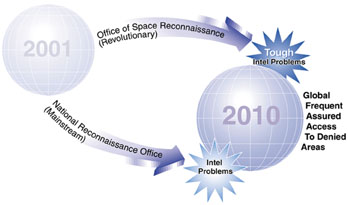
The NRO
must continue to evaluate and put into place leading edge technologies
to improve space reconnaissance and to meet the needs of its
broad customer base. It also must develop and operate space
reconnaissance systems to overcome the intelligence problems
confronting this same customer base. It must acquire and operate
high-technology spacecraft on behalf of the Secretary of Defense
and DCI to gain frequent, assured access to denied areas on
a global basis.
Recommendation
-
The
Secretary of Defense and the Director of Central Intelligence
should establish a new Office of Space Reconnaissance under
the direction of the Director of the NRO. The Office should
have special acquisition authorities, be staffed by experienced
military and CIA personnel, have a budget separate from other
agencies and activities within the National Foreign Intelligence
Program, be protected by a special security compartment, and
operate under the personal direction of the President, Secretary
of Defense and Director of Central Intelligence.
The
Secretary of
Defense-Director of Central Intelligence Relationship
The
tri-cornered arrangement among the Secretary of Defense, DCI
and NRO Director has at times provided great strength to the
NRO because it has allowed the NRO Director to draw on the resources
and benefit from the advocacy of the two major forces in the
Intelligence Community and DoD.
The Commission
has emphasized the need for the Secretary of Defense and DCI
to be fully aware of, and engaged in, NRO program decisions.
In that light, the Commission has reviewed the Secretary of
Defense and DCI responsibilities regarding the NRO.
The NRO
Director is the head of an agency of DoD that is also a major
component of the Intelligence Community. In addition, he serves
as the Assistant Secretary of the Air Force for Space. Under
four agreements dating back to the 1960s, the Director of the
NRO is responsible for reporting to both the Secretary of Defense
and the DCI. According to the NRO's General Counsel, all four
agreements are considered by the NRO to be still in effect,
although more recent statutory and Executive Order provisions
have added significant structure to the relationship. (See box
on facing page, "Summary of Secretary of Defense--DCI Agreements
Pertaining to the NRO." Also, a more detailed explanation
of the agreements and the historical development of the Secretary
of Defense-DCI relationship regarding the NRO is included in
Appendix D.)
Summary
of Secretary of Defense--DCI Agreements Pertaining to
the NRO
The
first agreement (1961) created the NRO to manage a DoD
National Reconnaissance Program (NRP) that included all
overt and covert satellite and over-flight reconnaissance
projects. The NRO was to function under the joint direction
of the Under Secretary of the Air Force and the CIA's
Deputy Director for Plans. Major NRP program elements
and operations were to be subject to regular review by
a National Security Council group.
A second agreement (1962) provided that the NRO Director
would be designated by both the DCI and Secretary of Defense
and be responsible directly to them for management of
the NRP. DoD and CIA personnel were to be assigned to
the NRO and DoD and CIA were to provide funds for the
NRO projects for which they were responsible.
In 1963, a third agreement superseded the prior version
and identified the Secretary of Defense as the Executive
Agent for the NRP and the NRO as a separate operating
agency within DoD. The NRO Director was now to be appointed
by the Secretary, with the concurrence of the DCI. A Deputy
NRO Director was to be appointed by the DCI, with the
concurrence of the Secretary. NRO budget requests were
to be presented by the NRO Director to the Secretary and
DCI, the Bureau of the Budget and congressional committees.
The NRO Director was to report directly to the Secretary
of Defense, while keeping the DCI currently informed.

The last agreement (1965) made clear the Secretary of
Defense had "ultimate responsibility" for the
NRO and eliminated the requirement for DCI concurrence
in the selection of the NRO Director. The DCI retained
authority for appointing the Deputy NRO Director, but
with the concurrence of the Secretary. This agreement
also provided that the Secretary was the final decision-maker
for the NRP budget and all NRP issues. It created an NRP
Executive Committee (EXCOM)--consisting of the Deputy
Secretary of Defense, DCI and the Assistant to the President
for Science and Technology--to "guide and participate"
in NRP budget and operational decisions, but the Secretary
of Defense was responsible for deciding any EXCOM disagreements.
|
The tri-cornered
arrangement among the Secretary of Defense, DCI and NRO Director
has at times provided great strength to the NRO because it has
allowed the NRO Director to draw on the resources and benefit
from the advocacy of the two major forces in the Intelligence
Community and DoD. To some degree, however, the uncertain situation
in which the NRO finds itself today--requirements rising, budgets
level or falling, and customers and mission partners demanding
greater roles in the NRO's decision-making process--can be traced
to the ambiguity and recent inadequacy of the Secretary of Defense-DCI
relationship as a means of resolving disputes relating to the
NRO.
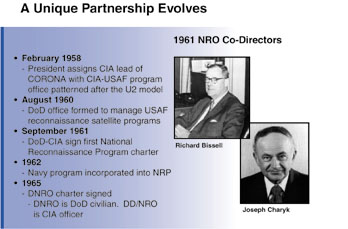
The Commission
believes history has shown it is possible for the NRO Director
to be responsive to both the Secretary of Defense and DCI and
that the dual reporting arrangement is valuable for the NRO
Director and should be continued. In previous years, for example,
the Secretary of Defense and DCI held weekly meetings that allowed
intelligence-related issues to be raised and resolved quickly
without having to percolate through the many layers of bureaucracy
that have come to separate the two officials from the NRO Director.
(See graphic, "Management Structure for the Intelligence
Community.") However, the Commission recognizes the relationship
is not self-executing and that its success requires the active
participation of both parties.
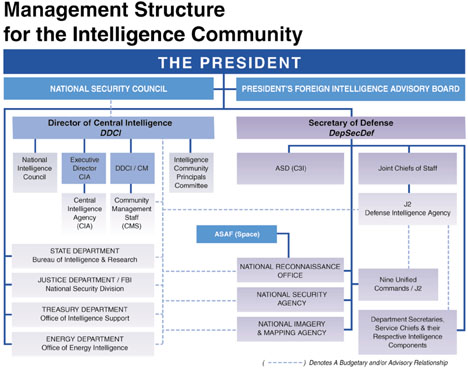
The Secretary
or the DCI may choose not to pursue this relationship. Successively
lower levels of officials may then be left to "manage"
the NRO on behalf of the two principals. Friction among the
NRO, the Intelligence Community and DoD has developed in such
periods. The Commission believes that the Secretary of Defense
and DCI must be involved in managing the NRO and that a close
working relationship must be established between them for this
purpose.
The Secretary
of Defense-DCI relationship with regard to the NRO could be
embodied in a comprehensive statute, as there is for NIMA, or
it could be established by statute mandating its completion
by a date certain. Alternatively, relatively minor amendments
could be made to the existing statutory scheme that would have
significant impact on the relationship. The relationship also
could be established by Executive Order or some other form of
Presidential Directive, a combination of statutory and Executive
Branch provisions, or a new agreement between the Secretary
of Defense and the DCI that would take account of the many changes
in the relationship that have occurred since 1965, the date
of the last of the previous agreements.
The Commission
evaluated the desirability of recommending the creation of an
"NRO statute." Such a law could firmly secure the
NRO's position in the national security community. After debate,
the Commission concluded that congressional action in this regard
could make the situation worse, rather than better. It believes
senior level Executive Branch attention should be sufficient
at this time.
Recommendations
-
The
President must take direct responsibility to ensure that the
Secretary of Defense and Director of Central Intelligence
relationship regarding the management of the NRO is functioning
effectively.
-
The President should direct the development of a contemporary
statement defining the relationship between the Secretary
of Defense and Director of Central Intelligence with regard
to their management of the NRO.
Balanced
Response to Customer Demands
Ensuring
a proper balance between strategic and tactical requirements--in
terms both of the use of current NRO systems and in the design
of future NRO systems--is a matter of utmost national security
importance.
Strategic
and tactical intelligence requirements determine the targets
against which current NRO systems collect every day. They also
have a direct and substantial impact on the design parameters
of future NRO systems.
Tactical
requirements include those generated by the Defense Intelligence
Agency, the military departments of DoD and the commanders of
the various U.S. military commands. They are generated in furtherance
of the U.S. military's responsibility to cope with contingencies
in any area of the world, to support the worldwide deployment
of U.S. armed forces and to organize, train and equip forces
for future military operations.
Strategic
requirements, on the other hand, include those generated by
the National Security Council, CIA, DoD, State Department, and
other civilian departments and agencies. These requirements
support U.S. Government policy officials, including those in
the White House and throughout the various departments and agencies
of the U.S. Government who participate in the development of
U.S. foreign, defense, military, economic, and technology policies.
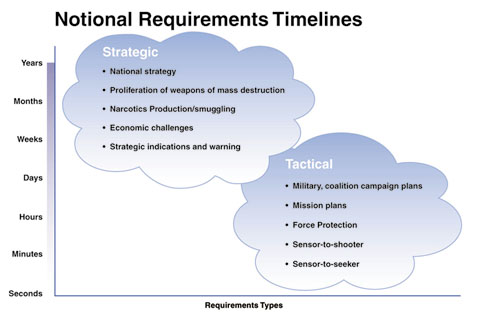
An extensive
debate has been underway for some time over whether NRO collection
resources are being properly allocated between strategic and
tactical intelligence requirements. The Jeremiah Panel, referred
to earlier, reviewed the state of the NRO and reported in 1996
that both strategic and tactical customers of the NRO were frustrated
with the requirements processes for both future systems and
daily operations. According to the Panel report, tactical customers
believed there was an insufficient NRO commitment to satisfying
their needs, while strategic customers believed that overhead
systems were being used, and future systems designed, primarily
for tactical customers and to the detriment of strategic customers.
The NRO
Director identified this tension between the NRO's strategic
and tactical customers as the first issue the Commission should
address because there is a belief that the NRO is responsible
when requirements are not satisfied. Substantial as the NRO's
present collection resources are, they cannot satisfy all requirements
all the time. Nor will future NRO systems, including the Future
Imagery Architecture, be able to satisfy all the needs of both
strategic and tactical customers. The NRO is thus caught in
the middle of the debate over the respective extents to which
strategic and tactical requirements should be satisfied by its
current systems and over the influence of those requirements
on the design of its future systems.
The classification
level of much of the data produced by NRO systems was lowered
during and after the Gulf War in response to congressional and
military pressure to make it more readily available to military
commanders in the field. As explained earlier, this action removed
the veil of compartmented secrecy from the NRO. In addition,
following the Gulf War, Congress emphasized the need to expand
the use of NRO systems to support military operations.
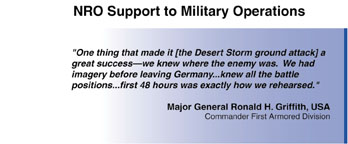
These developments
have brought a substantial increase in NRO collection requirements.
But there has been no corresponding increase in NRO funding.
As has been explained elsewhere in this Report, the program
for providing additional funds to the NRO from the DoD budget
through the Defense Space Reconnaissance Program for activities
related to military-unique requirements was eliminated in 1994.
Without such compensating resources, the shift toward expanded
support for military operations has stressed the capacities
of NRO systems to satisfy strategic, longer-term intelligence
needs.
The Commission
believes that ensuring a proper balance between strategic and
tactical requirements--in terms both of the use of current NRO
systems and of the design of future NRO systems--is a matter
of utmost national security importance. Factors that have made
this an issue include the growing expectations of the NRO's
expanding customer base and the lack of an effective policy
structure to clarify the NRO's mission and the allocation of
its resources in the face of these competing demands.
There also
appears to be no effective mechanism to alert policy-makers
to the negative impact on strategic requirements that may result
from strict adherence to the current Presidential Decision Directive
(PDD-35) assigning top priority to military force protection.
That Directive has not been reviewed recently to determine whether
it has been properly applied and should remain in effect.
It also
is significant that the interagency committees and components
that consider requirements for NRO systems were moved out of
the DCI's Intelligence Community management structure in the
early 1990s. These are now managed by the agencies with functional
responsibilities for the management of signals intelligence
(SIGINT) and imagery intelligence (IMINT), NSA and NIMA, rather
than being directed by officials with a broader view of the
needs of the Intelligence Community.

Day-to-day
collection requirements for current NRO IMINT systems are managed
by NIMA through an interagency process that includes representatives
of both the national and military customers. This process allocates
tasking of NRO imagery systems according to standing requirements
based on predetermined intelligence priorities. It allocates
daily tasking of these NRO systems in response to ad hoc requirements,
driven by current events, that may warrant a higher collection
priority. A similar, but somewhat more complicated, process
regarding collection requirements for NRO SIGINT systems is
managed by NSA.
Requirements
that will affect the design of future NRO IMINT and SIGINT systems
must be developed, presented and justified prior to the design
of those systems. This is a more technical and detailed process
than that for current requirements, and it may take months or
years. It also requires a sophisticated assessment by the NRO
and others of the cost and feasibility of providing the technology
needed to satisfy the various requirements set forth by the
customers. The most recent example was the 18-month requirements
process for the NRO's Future Imagery Architecture (FIA).
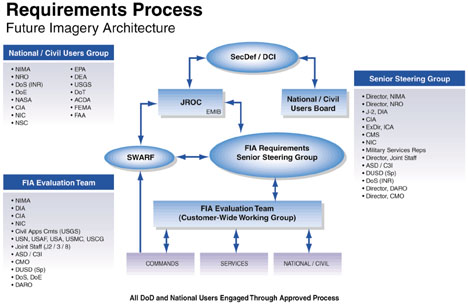
In the
FIA requirements process, the DoD customers benefited from a
well-established and systematic DoD requirements review process.
To aid non-DoD customers in developing and justifying such requirements
in the future, a Mission Requirements Board has been created
under the Deputy Director of Central Intelligence for Community
Management. If this Board functions properly, it should allow
strategic customers to compete on a more even footing with the
tactical customers.
It is clear
to the Commission that, in this area as well, it is up to the
President, Secretary of Defense and DCI to ensure that the priority
needs of both the strategic and tactical customers of intelligence
from NRO systems are satisfied now and in the future. The Commission
believes that direct and sustained attention by the Secretary
of Defense and the DCI is needed to resolve the current debate
in a way that ensures sufficient and proper coverage of both
strategic and tactical intelligence requirements by current
and future NRO reconnaissance systems.
In any
event, the President has assigned the highest current priority
to collection of intelligence in support of deployed U.S. military
forces. So long as this is the case, the needs of the strategic
customers will continue to be given secondary priority whenever
the two types of requirements conflict and the NRO systems cannot
accommodate both.
Recommendations
-
The
Secretary of Defense and the Director of Central Intelligence
must work closely together to ensure that proper attention
is focused on achieving the appropriate balance between strategic
and tactical requirements for NRO systems, present and future.
-
The Presidential Decision Directive (PDD-35) that establishes
priorities for intelligence collection should be reviewed
to determine whether it has been properly applied and should
remain in effect or be revised.
-
The imagery intelligence and signals intelligence requirements
committees should be returned to the Director of Central Intelligence
in order to ensure that the appropriate balance and priority
of requirements is achieved each day.
-
The Secretary of Defense and Director of Central Intelligence
should undertake an educational effort to ensure that Intelligence
Community members and customers are properly trained in the
requirements process, the cost of NRO support, and in their
responsibilities in requesting NRO support.
Defense
Space Reconnaissance Program (DSRP)
Pressures
on the National Foreign Intelligence Program to address requirements
that are uniquely military in nature are increasing and there
is no longer a DoD budget program element to offset the rising
cost to the NRO of meeting those requirements.
In the
1970s, the NRO's satellite collection capabilities and products
began to be made more broadly available to the military. The
expanded use of this data spawned the creation in 1981 of the
Defense Support Project Office (DSPO) within the NRO. DoD established
the Defense Reconnaissance Support Program (DRSP), under the
management of the DSPO, and used it as a mechanism to provide
additional funds from DoD to the NRO for systems development
and operations that directly contributed to the support of tactical
military users. Congress later authorized and appropriated specific
funding to the DSPO within the DRSP budget to ensure that military
warfighting requirements were addressed in the design and operation
of NRO satellites.
The DRSP
funds were generally used to meet unique military requirements
for NRO satellite reconnaissance systems. These funds, on the
order of several hundreds of millions of dollars, paid for additional
satellites or military-specific systems. The DRSP budget was
managed by the DSPO. The NRO Director also served as the Director
of the DSPO, thus ensuring that NRO program offices were responsive
to the needs and requirements of both the Intelligence Community
and the military departments.
Between
1981 and 1994, the NRO was authorized and appropriated annual
funds from both the National Reconnaissance Program (NRP) element
of the National Foreign Intelligence Program budget (NFIP) and
the DRSP element of the Tactical Intelligence and Related Activities
(TIARA) program budget. The NRP was used to pay for Intelligence
Community requirements for development, operation and maintenance
of NRO satellite reconnaissance systems, as well as NRO innovative
technology activities. Supplemental funding for NRO efforts
to satisfy military requirements was provided from DoD's DRSP
budget.
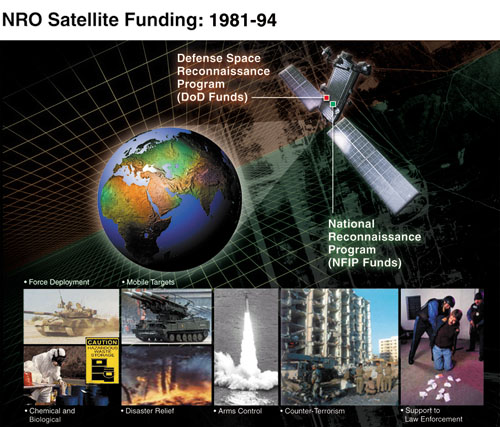
A 1994
agreement between the Deputy Secretary of Defense and the DCI
transferred all of the satellite acquisition and infrastructure
funding into the NRP. As a result, DRSP funding was reduced
to tens of millions of dollars per year to be spent on helping
military customers learn how to use collection and processing
systems effectively. The DRSP was renamed the Defense Space
Reconnaissance Program (DSRP).
The effect
of this 1994 agreement is that NRO efforts to support both Intelligence
Community and military requirements are now paid for out of
the NRP budget. In 1999, Congress directed the abolition of
the DSPO and its functions were transferred to the NRO Deputy
Director for Military Support.
As explained
earlier, military requirements have continued to grow and contention
for NRO satellite resources has increased. The number of extended
U.S. military commitments and other U.S. interests around the
globe that require continuing support is also stressing the
capacity of NRO reconnaissance systems to detect critical indications
and warnings of potentially threatening events.
Pressures
are increasing, as a result, on the NRP and NFIP to address
these requirements--even those uniquely military in nature.
Yet there is no longer a DoD budget program element to offset
the rising cost of meeting those requirements as there was when
the DRSP competed against other DoD budget requirements to provide
the needed funds.
Experience
since 1994 suggests that adaptations of NRO systems for tactical
purposes have met with increasing difficulty competing within
the NFIP budget and that NRP spending on tactical needs is seen
as a drain on the Intelligence Community and the NFIP. Military
influence toward improving the tactical support capabilities
of future satellite systems is limited because the Intelligence
Community believes that many of the proposed improvements are
DoD-unique and should not be paid for by the NFIP.
The Commission
believes it is time to reinstitute DSRP funding for NRO programs.
Besides easing the budget pressures, this would help sensitize
military users to the costs associated with added requirements
and reduce the current tendency to view NRO products as a "free"
commodity with no value attached and no cost-benefit measurement
against competing demands.
The Commission
supports the language in the report accompanying the Fiscal
Year 2001 DoD Authorization Act that parallels the findings
of the Commission. That report states that the DSRP has served
an important role in providing direct interactions among the
NRO and operational military commanders and other elements of
DoD. It also states that the Secretary of Defense needs to evaluate
the overall role of the NRO in supporting tactical military
forces.
This evaluation
is to include a review of, among other things, whether a revitalized
DSRP would be the best mechanism for giving the Unified Commands
a role in determining future space intelligence and reconnaissance
capability requirements and raising the visibility of space
reconnaissance matters within the DoD program planning and resource
allocation process. The evaluation also is to include the role
of a revitalized DSRP in funding NRO system developments to
satisfy unique military requirements. The Authorization Report
directs the Secretary of Defense to provide the congressional
defense and intelligence committees a report by May 1, 2001
on his assessment and recommendations in these regards.
Recommendation
-
The
Secretary of Defense, in consultation with the Director of
Central Intelligence, should re-establish the Defense Space
Reconnaissance Program as a means of funding tactical military
requirements for NRO systems and architectures.
Increased
Resource and Budgetary Flexibility
The
DCI should have greater latitude to redirect funds among intelligence
collection areas and agencies in order to respond most effectively
to the specific types of program issues that arise at the NRO.
The provisions
of the 1997 Intelligence Authorization Act were intended, among
other things, to enhance the authority of the DCI in regard
to the annual NFIP budget. Thus, the DCI is required to approve
any reprogramming of NFIP funds by any Intelligence Community
element.
The DCI
was also given authority to transfer funds or personnel within
the NFIP budget to meet unforeseen and higher priority intelligence
requirements. However, that authority is conditional on the
agreement of the "Secretary or head of the department which
contains the affected element or elements...." This requirement
for agreement could negate the DCI's ability to move personnel
and financial resources around the Intelligence Community, including
to or from the NRO, to deal with unexpected contingencies and
technological or other developments.
In this
respect, the Commission notes that Section 105 of the FY 2001
Intelligence Authorization Act has ameliorated this situation
somewhat in favor of the DCI. That section provides that only
the Secretary or head of an agency has the authority to object
to a transfer of funds within the NFIP and that such objections
must be in writing. The Act further provides that, within the
Department of Defense only, the Deputy Secretary of Defense
may be delegated the authority to object for the Secretary and
that the Deputy Director of Central Intelligence for Community
Management may be delegated the DCI's authority to transfer
funds.
Recommendations
-
The
Director of Central Intelligence should be granted greater
latitude to redirect funds among intelligence collection activities
and agencies in order to respond most effectively to the specific
types of issues that arise in NRO programs.
-
Transfers greater than $10 million would continue to require
the concurrence of the affected Secretary or agency head.
This could be coupled with a provision to allow a Secretary
or agency head who has objections to such transfers the opportunity
to appeal the Director of Central Intelligence's decision
to the President.
-
The requirement that such transfers be made known to the appropriate
congressional committees should not be altered.
NRO
Technical Expertise
The
Commission believes there is a compelling need for an NRO career
path and assignment policy that provides the opportunity for
highly trained engineers and acquisition and operations specialists
to be assigned to and progress through a broad range of NRO
positions.
The NRO's
success is directly attributable to the high quality and creativity
of the DoD, CIA and contractor workforce that has been dedicated
to supporting the NRO. The overwhelming majority of the U.S.
Government personnel who work at the NRO are employees of the
CIA or DoD who have been assigned to the NRO for some portion
of their careers and who have the technical expertise needed
for complex NRO programs. A substantial number of these are
active duty military personnel.
Until recently,
many of these personnel served the majority of their careers
with the NRO, transferring among its acquisition, development,
launch, and operating elements. Some never returned to their
parent organization for any appreciable length of time. This
allowed a highly skilled cadre of personnel to advance within
the management structure of the NRO, gaining experience at various
levels of its technical, financial and acquisition programs
along the way. Promising young military and CIA officers were
groomed to become the NRO program managers of the future. Long
tenure and accomplishment at the NRO were valued by their parent
organizations and these personnel were promoted along with,
and sometimes ahead of, their peers who followed more traditional
career paths within their agency or military service.
With the
transition from separate programs to a functionally-based organization,
there is no longer a unique career path for many of the personnel
assigned to the NRO. For example, in the past when there were
independent Air Force, CIA and Navy elements called Programs
A, B, C, and D, Air Force personnel in Program A were assigned
to the Secretary of the Air Force Office of Special Programs
(SAFSP). They were hand-selected for assignment to the NRO and
their careers were managed by SAFSP. This Air Force element
was directly tied to the strategic mission of the Air Force
to monitor the Soviet Union's nuclear forces. As a result, there
were clear incentives for the Air Force to contribute to the
NRO mission, promote Air Force identity and mentor and care
for its people efficiently.
Likewise,
Program B, which was staffed by personnel from the CIA's Directorate
of Science and Technology (DS&T), had its own unique identity
and career path within the DS&T Office of Development &
Engineering. Those personnel also were hand-selected for a career
within the NRO. They were tied directly to the CIA's strategic
intelligence mission and the requirements generated by the DS&T
and had very clear objectives and career paths to become managers
of the NRO's Program B systems.
New personnel
assignment practices adopted by the parent organizations have
had the effect of limiting the tenure of personnel assignments
to the NRO. Because rotational assignments back to these organizations
appear to be a requirement for career advancement beyond a certain
grade, there is a resulting concern that the NRO could lose
its ability to sustain the cadre of highly-skilled and experienced
personnel it needs to guarantee mission success. In some cases,
this cadre is prevented from gaining equivalent broad space-related
experience during the rotational assignments. While it is understandable
that a parent organization may want to exploit the special skills
their personnel develop in the NRO, the cost to NRO space reconnaissance
programs is likely to be greater than the value of broader experience
to these other organizations.
In fact,
serving too much time supporting the development and acquisition
of our nation's most sensitive and unique space reconnaissance
systems is often seen as detrimental to one's career. Also,
there are no longer any separate military service elements (Air
Force, Navy, and Army) within the NRO to monitor personnel assignments
or career progression.
The Commission
believes there is a compelling need for an NRO career path and
assignment policy that allows highly trained engineers and acquisition
and operations specialists to be assigned to and progress through
a broad range of NRO positions. In this respect, the Commission
notes that Section 404 of the FY 2001 Intelligence Authorization
Act enables the DCI to detail CIA personnel to the NRO indefinitely
on a reimbursable basis and to hire personnel for purposes of
detailing them to the NRO.
The Commission
recognizes that there may be assignment possibilities within
other U.S. Government space or technical programs that could
contribute to the professional development of these personnel.
However, the technical complexity of NRO systems is unique,
and mission success requires the continuity of a dedicated cadre
of personnel skilled in the development, acquisition and operation
of those systems.
Recommendation
-
The
Secretary of Defense and the Director of Central Intelligence
should jointly establish NRO career paths to ensure that a
highly skilled and experienced NRO workforce is continued
and sustained.
Increased
Launch Program Risks
There
appears to be no national strategy or effective and engaged
National Security Council-level mechanism to provide the guidance
and oversight needed to ensure a robust national space reconnaissance
architecture. This has led to a situation in which failures
in existing or new spacecraft and launch vehicles could result
in significant gaps in the intelligence coverage that is available
from NRO systems.
The Commission
believes the current status of the NRO satellite and launch
program dramatically highlights the need for active participation
and leadership by the Secretary of Defense and DCI in managing
the nation's space reconnaissance program. Because the NRO is
managed jointly by the Secretary of Defense and DCI, it is essential
that its operating responsibilities be clear and allow for sufficient
review of program decisions by other affected agencies. Such
reviews are consistent with the responsibilities of the Secretary
of Defense and DCI to assure global access through space reconnaissance.
Without such senior involvement, there is a real risk that NRO
program decisions will be made without a full appreciation of
their consequences for overall national security.
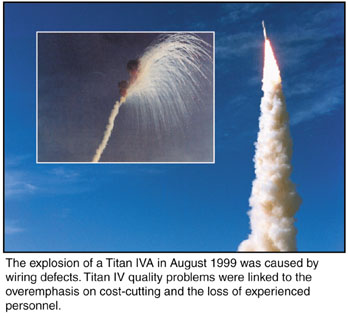
The Commission
is alarmed that one particular potential vulnerability in the
NRO's programs has arisen that might have been avoided with
proper foresight, leadership and review at the national decision-making
level. The NRO is now on a path that leads toward a future period
of unprecedented risks inherent in concurrent satellite and
launch vehicle development and transition. It is developing
new spacecraft that will be launched by new launch vehicles.
Today, the fragility of the satellite and launch architectures
offers no margins for error.
Historically,
spacecraft and launch vehicle development programs have failed
to meet their original estimated delivery dates. In addition,
the initial spacecraft and launch vehicles that emerge from
new development programs have often experienced failures because
of design flaws that were not discovered prior to their first
flights. In the past, such delays and failures could usually
be mitigated because the NRO either had robust satellite capabilities
in orbit, or had satellites or launch vehicles in production
that could be accelerated to fill any gaps.
Today,
however, sufficient NRO contingency capability does not exist
and has not been budgeted. The number of current launch vehicles
that remain available to the NRO until the U.S. Government-sponsored
Evolved Expendable Launch Vehicle (EELV) program is completed
is strictly limited to those necessary for planned NRO launches.
In addition, the NRO has adopted more optimistic assumptions
for the operational lifetimes for its current satellite systems
than it has in the past.
The NRO
believed that a significant number of commercial and other U.S.
Government launches would demonstrate the reliability of EELV
launch vehicles long before the NRO would be required to launch
its newly developed satellites on them. This has not happened
and current launch projections indicate NRO satellites are scheduled
to fly on very early EELV launch vehicles.
In addition,
the EELV and some NRO satellites under development are now using
an acquisition reform management approach that may cut costs,
but has proven to be controversial since it involves less participation
by skilled U.S. Government and contract personnel in overseeing
the work of satellite and launch vehicle manufacturers. NASA
has acknowledged that some of its recent satellite problems
directly correlate with programs involving less Government participation
and use of acquisition reform techniques. The application of
these new acquisition reform techniques and commercial practices
to the EELV, and to some NRO programs, may add additional risks
and uncertainty relative to technical, schedule and cost success.
The Commission
is vitally concerned about the implications of this unprecedented
period of concurrent satellite and launch vehicle development
and transition that could have major impacts on the U.S. space
reconnaissance program. The decisions that have brought about
this situation have been based upon resource constraints and
NRO assessments. The decisions have not been adequately reviewed
at the highest levels of the U.S. Government to assess their
overall implication for the national security posture.
The Commission
notes the painful lesson of the 1980s that grew out of the decision
to launch all NRO satellites from the Space Shuttle. Following
the Challenger disaster and the suspension of Space Shuttle
flights, the NRO was forced to reconfigure its satellites for
other launch vehicles. This cost billions of dollars and placed
U.S. national security at risk during the period when replacement
satellites could not have been launched if circumstances had
so required.
There appears
to be no national strategy or effective and engaged National
Security Council-level mechanism to provide the guidance and
oversight needed to ensure a robust national space reconnaissance
architecture. This has led to a situation in which failures
in existing or new spacecraft and launch vehicles could result
in significant gaps in the intelligence coverage that is available
from NRO systems.
Recommendations
-
The
NRO Director, with the support of the Air Force Materiel Command
and Space and Missile Systems Center, should develop a contingency
plan for each NRO program or set of programs. These plans
should describe risks, contingency options and failure mitigation
plans to minimize satellite system problems that might result
from satellite or launch vehicle failures.
-
The Secretary of Defense and Director of Central Intelligence
should establish independent teams to conduct pre-launch assessments
of non-traditional areas of risk. These teams should be made
up of recognized space launch experts and be granted whatever
special authorities and accesses are required to perform their
duties.
-
The Commission to Assess United States National Security Space
Management and Organization should evaluate the need for an
improved organization structure to provide launch capability
and operations for the deployment and replenishment of NRO
and DoD satellites.
Commercial
Satellite Imagery
The
U.S. Government could satisfy a substantial portion of its national
security-related imagery requirements by purchasing services
from the U.S. commercial imagery industry.
Background.
The NRO's future could be affected significantly by the degree
to which it is able to exploit the ongoing development of a
competitive commercial space imagery industry. That industry
is in an embryonic stage in the United States and abroad, but
the technology available to it is already mature. According
to a recent classified U.S. Government study, the U.S. Government
could satisfy a substantial portion of its national security-related
imagery requirements by purchasing services from the U.S. commercial
imagery industry.
The National
Space Policy promulgated by Presidential Decision Directive-49
in September 1996 includes Commercial Space Guidelines to promote
the development of a competitive U.S. commercial space imagery
industry. The stated goal of the Policy is to enhance U.S. commercial
space activities while at the same time protecting U.S. national
security and foreign policy interests.
The Policy
further directs U.S. Government agencies to purchase "commercially
available" space goods and services to the fullest extent
"feasible" and not to conduct activities with commercial
applications that deter commercial space activities, except
for reasons of national security or public safety.
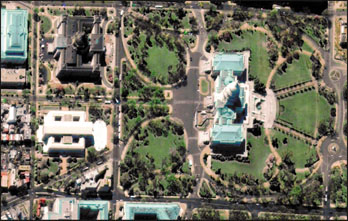 |
| One-meter
pan-sharpened color image of the U.S. Capitol, collected
by Space Imaging's Iknoos satellite. This image demonstrates
current, first-generation commercial space imagery capability. |
The 1996
Space Policy also explains that the U.S. Government will not
provide direct federal subsidies to the commercial space industry.
It should, however, facilitate "stable and predictable"
U.S. commercial sector access to appropriate Government space-related
hardware, facilities and data to stimulate private sector investment
in and operation of space assets.
Over the
last several years, NRO and NIMA officials have considered the
means by which the commercial imagery industry could complement
U.S. Government collection, analysis and dissemination capabilities
to support Government needs. Substantial Government purchases
of commercial imagery were promised. As a result, there were
high expectations in the private sector.
However,
such purchases have been relatively insignificant. Questions
have been raised about the effectiveness of the Government's
plan for buying imagery products and services. Criticism has
been directed at the process for transferring Government technologies
that will be needed if the U.S. commercial imagery industry
is to be successful. How these issues are resolved will have
a great impact on the long-term viability of the industry and
its ability to generate products and services of use to the
U.S. Government.
Space
Imagery as a "Commodity." The basic technology
for collecting and processing high-resolution images from
space has become available to an increasing number of nations.
Ally or adversary, all nations that have developed or are
developing a space-based imagery capability have expressed
an intention to serve civil sector needs and, in most cases,
to offer the images to the commercial market.
Government
Acquisition of Commercial Imagery. Over time, the Government
has clearly tended toward greater dependence on private sector
sources for many of its needs. This has included an extraordinary
range of technologies, components, subsystems, and services,
as well as integrated systems ranging from microelectronics
to space launch vehicles.
A decision
to rely on commercial imagery to supply some portion of U.S.
Government imagery needs necessarily raises questions about
whether the private sector can be relied on to provide services
of sufficient quality and timeliness. Further questions relate
to how best to structure Government procurement of commercial
imagery.
Of no less
importance is the question of whether domestic or international
sale of high-resolution images will adversely affect the interests
of the U.S. Government. These interests include ensuring the
security of U.S. and allied military deployments and operations
and preventing U.S. adversaries from acquiring information that
will aid them in conducting denial and deception operations.
The U.S.
commercial imagery industry has made substantial investments
in current first-generation space imaging systems and it proposes
to make even larger investments in planned second-generation
systems. It is also making additional investments to improve
the quality, accuracy and timeliness of these systems. Many
of these improvements respond to earlier U.S. Government assessments
that were skeptical of the utility of commercial imaging systems
to the Government.
The commercial
imaging industry has received mixed signals from the U.S. Government.
While the NRO and NIMA have publicly expressed support for the
commercial imaging industry, only minimal Commercial Imagery
Program funding has been made available to the industry and
future funding has not been added.
The lack
of U.S. Government commitment to acquire commercial imagery
is further demonstrated by managerial problems that have emerged
in NIMA's Commercial Imagery Program. There is no continuity
in the Program and the program manager has been changed frequently.
The Commission
supports Government purchases of one meter and one-half meter
resolution commercial imagery, which can meet a large percentage
of U.S. Government imagery requirements. Because of the lack
of demonstrated commitment, the Commission believes there is
a need for an overall assessment--independent of the NRO--of
the utility of commercial technologies to supplement traditional
NRO missions.
Assuming
that imagery of the required resolution and timeliness is available
from both the NRO and the commercial imagery industry, under
present procedures NIMA will have a natural preference for NRO
imagery over commercial imagery. NIMA does not have to purchase
NRO imagery; it is "free."
To deal
with similar tendencies in determining whether to use military
or commercial airlift capabilities, DoD has created an industrially
funded account. The manager of this account determines for the
customer whether military or civilian airlift best meets the
customer's needs within the budget resources available. Thus,
the use of a C-17 aircraft for a routine peacetime cargo flight
to a modern European airport is unlikely since a commercial
aircraft could perform the same task far more cheaply. The military
aircraft would be chosen when circumstances (e.g., unprepared
runways) justify doing so.
With regard
to U.S. Government imagery requirements, a number of critical
national security interests can only be met by Government systems.
However, a large number of targets can be covered by commercial
capabilities. Through an approach to imagery analogous to DoD's
military/civilian airlift practice, Government systems would
be focused on targets where their unique capabilities in resolution
and revisit times are important, while commercial systems would
be used to provide processed "commodity" images.
In the long
term, such a division of labor between the public and private
sectors will allow the commercial sector to develop without
a U.S. Government subsidy. A predictable market will be created,
and private sector investors will be able to establish an infrastructure
to meet predictable U.S. Government needs. Current Government
acquisition practices for commercial imagery have helped create
an unpredictable market. This substantially increases the risk
to investors and diminishes the ability of the commercial imagery
sector to meet U.S. Government needs.
Government Licensing of Commercial Imagery Systems. In March
1994, President Clinton signed Presidential Decision Directive
(PDD)-23 establishing a policy permitting U.S. firms to obtain
licenses to market imagery products and systems commercially.
Its stated goal was to enhance U.S. competitiveness in space
imagery capabilities, while protecting U.S. national security
and foreign policy interests.
Delays
in the U.S. Government licensing approval process, along with
several recent failures in commercial satellite ventures and
the mixed signals on purchases by the U.S. Government described
earlier, are causing investors to reevaluate their financial
support for the U.S. space imagery industry. This financial
environment, coupled with the decline in the scale and pace
of U.S. Government satellite programs, is weakening the portion
of the U.S. industrial base that provides the foundation for
the NRO's space programs. The skilled workforce on which both
the NRO and the commercial imagery industry rely has been eroding,
while research and development investment that leads to the
technological change necessary for the United States to maintain
its global dominance in space has been falling.
In some
cases, particularly those involving "first time" applications
for licensing of newer technologies, U.S. commercial imagery
firms report having faced delays of more than 30 months in getting
responses to licensing applications. This is far longer than
even the processing time now needed for an export license for
defense products.
Planning,
building and placing a commercial satellite in orbit requires
approximately three to five years to meet required launch and
replenishment schedules. In the private sector, strict adherence
to these schedules is essential to persuade customers and investors
that services will be provided as advertised and that earnings
projections will be met. Obviously, a wait of three years for
the needed license approvals is not consistent with a commercial
space imagery initiative on a five-year development schedule.
The way
in which U.S. policy on licensing of commercial imagery initiatives
is being implemented is likely to have an adverse effect on
the long-term security, commercial and industrial interests
of the United States. The present impediments to acquisition
and development of commercial imagery will diminish the industrial
base available to support U.S. Government space-based imagery
needs.
Meanwhile,
foreign competitors in the commercial imagery industry enjoy
relative freedom from U.S. export and licensing controls. These
foreign firms could dominate the global remote sensing market
in the 2005 timeframe if their U.S. counterparts are stymied
by an ineffective national strategy and a U.S. Government bureaucracy
that cannot keep pace with the global marketplace. The United
States is in danger of losing an opportunity to develop this
market, while stimulating foreign investment in it.
U.S. Defense
and Intelligence Community officials are justly concerned that
such high-resolution imagery could give adversaries of the United
States the ability to monitor U.S. intentions and capabilities,
particularly during future crises involving tactical military
operations. While this risk certainly exists, current law allows
the United States to exercise "shutter control" over
U.S. commercial space imagery vendors and systems where necessary
for national security or foreign policy reasons. This authority
alleviates the risk to some extent.
More significantly,
however, impeding the access of U.S. industry to this market
is more likely to increase, rather than diminish, this risk
by creating incentives for investors to create a capability
outside the United States. Several countries are likely to possess
high-resolution imagery satellites by 2005. As a result, whether
or not U.S. companies are granted licenses to proceed with such
systems, it appears that high-resolution imagery eventually
will be available on the open market to anyone who can afford
the price.
Report
of the National Imagery and Mapping Agency Commission. As
the Commission was in the final stages of preparing this Report,
the Commission to Review the National Imagery and Mapping Agency
(NIMA) made its report available. The Commission is pleased
to note that the findings and recommendations of both reports
are in close agreement in the area of commercial imagery. The
Commission also joins the NIMA Commission in applauding the
National Security Council's recent decision to approve two license
applications for a one-half meter resolution commercial imagery
satellite.
Recommendations
-
A clear national strategy that takes full advantage of the
capabilities of the U.S. commercial satellite imagery industry
must be developed by the President, Secretary of Defense and
Director of Central Intelligence.
-
The strategy must contain a realistic execution plan--with
timelines, a commitment of the necessary resources and sound
estimates of future funding levels.
-
The strategy also should remove the current fiscal disincentives
that discourage use of commercial imagery when it is technically
sufficient to meet user needs.
-
The NRO should work with NIMA to develop a new acquisition
model for commercial imagery that will help create the predictable
market necessary for the industry to become a reliable supplier
to the U.S. Government. The acquisition model should include
provisions for the pricing of imagery to the user from either
the commercial or Government sources that reflect the cost
of acquiring such images to the U.S. Government.
-
The Secretary of Defense and the Director of Central Intelligence
should develop a strategy that recognizes the threat posed
to the United States by the likely availability of commercial
space imagery to opponents of the United States.
NRO
Airborne Reconnaissance Responsibilities
Too
often, space reconnaissance and strategic airborne reconnaissance
are viewed as mutually exclusive capabilities.
Strategic
airborne reconnaissance requires serious attention. The earliest
NRO reconnaissance successes included strategic airborne, as
well as space, platforms. Examples include the U-2 and SR-71
aircraft. Although the NRO still has responsibility for such
systems according to a 1964 DoD Directive still in effect, the
Commission is unaware that any strategic airborne reconnaissance
systems are being considered for further development by the
NRO.
Too often,
space reconnaissance and strategic airborne reconnaissance are
viewed as mutually exclusive capabilities. In fact, they are
quite complementary and contribute unique support to a tiered
concept of intelligence collection.
Space-based
reconnaissance can monitor the entire globe in an unobtrusive,
non-threatening way. However, satellites cannot supply long-term,
uninterrupted, focused, multi-intelligence coverage of a limited
area of interest. Airborne reconnaissance can supply excellent
coverage of limited areas, but can be threatened by hostile
action and affected by over-flight restrictions.
Aircraft
payloads can be changed for specific missions and updated as
technology improves. Satellite payloads are fixed in design
early and flown for the life of the vehicle with limited ability
to update functions. If a tiered collection management scheme
were used to combine satellite "tip off" and "deep
look" capabilities with aircraft flexibility and dwell
capabilities, national strategic and tactical requirements would
be well served.
In the
early 1990's, the Defense Airborne Reconnaissance Office (DARO)
was established. This was intended in part to provide a comprehensive
approach to all strategic and tactical airborne reconnaissance
platforms. When DARO was abolished, responsibilities for the
development of airborne reconnaissance systems passed to the
military services. The Intelligence Community therefore has
to depend on the military services for intelligence from airborne
platforms.
Very high
altitude, long range airborne reconnaissance systems provide
strategic value and accessibility. These systems merit continued
examination by the NRO in light of the features they share in
common with space systems.
To achieve
and maintain a proper balance between space-based and airborne
reconnaissance, the Commission believes the NRO needs to restore
its interest in airborne platforms and participate in engineering
studies to select the proper platform for the required mission.
Recommendation
-
The NRO should participate jointly with other agencies and
departments in strategic airborne reconnaissance development.
Specifically, the NRO should supply system engineering capabilities
and transfer space system technologies to airborne applications.
|



